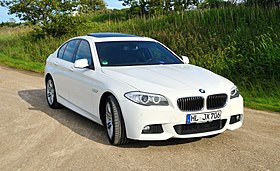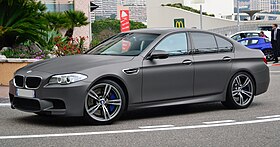BMW F10
| BMW 5-series (F10/F11/F07) |
|
|---|---|
 |
|
| Overview | |
| Manufacturer | BMW |
| Production | Jan 2010 – Mar 2017 |
| Model years | 2011–2017 |
| Assembly | Germany: Dingolfing China: Shenyang (BBA) Egypt: 6th of October City (BAG) India: Chennai Indonesia: Jakarta Malaysia: Kulim (Inokom) Mexico: Toluca Russia: Kaliningrad (Avtotor) Thailand: Rayong (BGMT) |
| Designer | sedan: Jacek Fröhlich Wagon: Jean-Francois Alexandre Huet |
| Body and chassis | |
| Class | Mid-size luxury / Executive car (E) |
| Body style | 4-door saloon 5-door wagon (estate) |
| Layout |
FR layout, F4 layout (xDrive models) |
| Related | 5 Series Gran Turismo (F34) |
| Powertrain | |
| Engine |
Petrol 1.6 - 2.0 L N20 I4 turbo 2.5 - 3.0 L N52 I6 NA 3.0 L N55 I6 turbo 4.4 L N63 V8 turbo Diesel: 2.0 L N47 I4 turbo 3.0 L N57 I6 turbo |
| Transmission | 6-speed manual 8-speed ZF 8HP automatic |
| Dimensions | |
| Wheelbase | 2,968 mm (116.9 in) |
| Length | sedan: 4,907 mm (193.2 in) |
| Width | 1,860 mm (73.2 in) |
| Height | sedan: 1,464 mm (57.6 in) |
| Curb weight | 3,714 lb (1,685 kg) |
| Chronology | |
| Predecessor | BMW 5 Series (E60) |
| Successor | BMW 5 Series (G30) |
| BMW F10 M5 | |
|---|---|
 |
|
| Overview | |
| Production | 2011-2017 |
| Model years | 2012-2017 |
| Assembly | Germany: Dingolfing |
| Designer | Adrian van Hooydonk |
| Body and chassis | |
| Body style | 4-door saloon/sedan |
| Layout | FR layout |
| Related | BMW 5 Series |
| Powertrain | |
| Engine | 4.4L (4395 cc) V8 Twin Turbo |
| Transmission | 7-speed dual clutch transmission 6-speed manual |
| Dimensions | |
| Wheelbase | 2,964 mm (116.7 in) |
| Length | 4,910 mm (193.3 in) |
| Width | 1,892 mm (74.5 in) |
| Height | 1,451 mm (57.1 in) |
| Kerb weight | 1,945 kg (4,288 lb) |
| Chronology | |
| Predecessor | E60 M5 |
The BMW F10 is the sixth generation of the BMW 5 Series, which debuted in November 2009 as the successor to the E60 5 Series. The body styles of the range are:
The F10 was the first 5 Series to be available in a hatchback body style. It was also the first 5 Series to offer a hybrid drivetrain and a dual-clutch transmission (in the M5).
The M5 version was powered by the S63 twin-turbo V8 engine with a 7-speed dual clutch transmission. It was the first M5 to use a turbocharged engine.
The F10 uses a more traditional BMW exterior styling approach compared with the controversial styling of its E60 predecessor. The "Bangle butt" is removed, a Hofmeister kink is present, a traditional kidney grill is used and crease lines are used on the bonnet (similar to the E39 and older 5 Series models). Reviews of the styling have ranged from slightly bland, to handsome and muscular. The newer F10 bodystyle takes a back to basics approach with the exterior and features many styling cues from older 5 series designs such as the E34.
The interior features an updated iDrive system and increased space for rear passengers. The F10 saw the return of the centre console being angled towards the driver, as used on the E39 and earlier generations of 5 Series. Back seat space is still tight for a car of this size but comfort for all passengers is high and interior quality/fit and finish is top notch.
The F10 shares a platform with the BMW 7 Series (F01) and has been described as a downsized-7 Series in contrast to its E60 predecessor which was regarded as an upsized 3 Series. Improvements over the E60-generation 5-series include a front dual ball joint short-long arm suspension, and rear multilink suspension, making it more refined but heavier. While the E60 had an aluminum front chassis structure from firewall forward (which provided perfect balance but was expensive to repair), the F10 has returned to the conventional steel monocoque. The 2011 model has a rollover risk of 9.3%. While the F10 still handles quite well for a vehicle of its size, It is very heavy and tuned more to satisfy customers looking for comfort. handling is capable, but more ponderous and far less direct then BMW's of the past and lots of soft body roll at the limit.
...
Wikipedia
